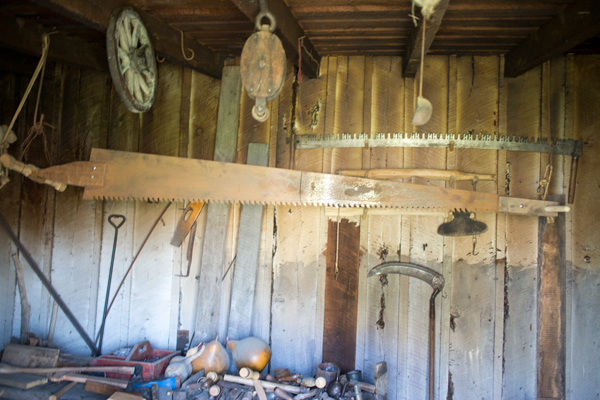Whip and Crosscut Saws
Photo © 2015 by Kristopher K. Townsend. Permission to use granted under the Creative Commons Attribution-Share Alike 4.0 International license.
The long saw is a two-man whip saw, used to cut planks from a log. The shorter saw is a two-man crosscut, used to cut logs to length. Both saws require coordination between the two sawyers to be effective.
—Kristopher K. Townsend, ed.
When he deserted, Reed likely took one of these rifles. Which one Lewis had prepared at Harpers Ferry is a matter of speculation and debate. See Muskets and Rifles on this site.
—KT
Winter at Camp Dubois
He had spent the winter of 1803–1804 at Camp Dubois, where he labored as a sawyer—apparently work unfamiliar to him. Clark dryly observed, on 6 January 1804: “The Sawyears, come on to day better than usial, Whitehouse & Reed, agree better than they did last week—or in other Words Re[ed] Saws better from practice.”
Clark trusted Reed well enough to send him to St. Louis carrying letters twice, in April and in May 1804, and noted his hunting contribution when the private brought in a “bobcat.”
Sole Enlisted Deserter
On 4 August 1804, after the expedition moved upstream from their Council Bluff camp, Reed announced that he had left behind his knife. As always with the irreplaceable tools, he was sent back to get it. He did not catch up that night, becoming the third Corps member missing. Engagé La Liberté had not yet returned from his assignment to invite the Otos to a council, and George Shannon was lost but trying hard to catch up.
The next day, Clark wrote that “we have Some reasons to believe he has Deserted,” and Charles Floyd‘s journal for 7 August 1804 explains those reasons:
pon examining his nap-Sack we found that he had taken his . . . Cloas and all His powder and Balles, and had hid them out that night and had made that [left knife] an excuse to Desarte from us with out aney Just Ca[u]se.”[1]Moulton, ed., Journals, 9:393.
After waiting three days for Reed to return, four men—George Drouillard, William Bratton, François Labiche and Reubin Field—were sent to locate Reed and La Liberté. The latter was a civilian, as for Reed, the men went “with order if he did not give up Peaceibly to put him to Death.”
Reed was brought into camp on 18 August 1804 and tried. He confessed to desertion and stealing a “public Rifle” and ammunition, but begged mercy. He was sentenced to run the gauntlet four times, hit by nine switches each that the other men wielded, and was banished from the Corps. Reed would be allowed to stay the winter at Fort Mandan, performing hard labor.
He was in trouble again two months later, with only Sgt. John Ordway recording that Reed and John Newman were “confined” the day before Newman’s trial for mutiny. After that, no journalist mentions Reed again. In April 1804, Moses Reed returned to St. Louis on the the barge (called the ‘boat’ or ‘barge’ but never the ‘keelboat’).
Notes
| ↑1 | Moulton, ed., Journals, 9:393. |
|---|
Experience the Lewis and Clark Trail
The Lewis and Clark Trail Experience—our sister site at lewisandclark.travel—connects the world to people and places on the Lewis and Clark Trail.
Discover More
- The Lewis and Clark Expedition: Day by Day by Gary E. Moulton (University of Nebraska Press, 2018). The story in prose, 14 May 1804–23 September 1806.
- The Lewis and Clark Journals: An American Epic of Discovery (abridged) by Gary E. Moulton (University of Nebraska Press, 2003). Selected journal excerpts, 14 May 1804–23 September 1806.
- The Lewis and Clark Journals. by Gary E. Moulton (University of Nebraska Press, 1983–2001). The complete story in 13 volumes.



